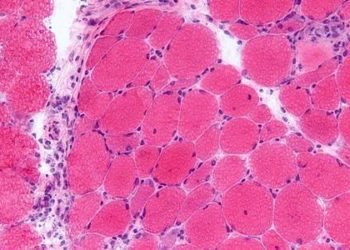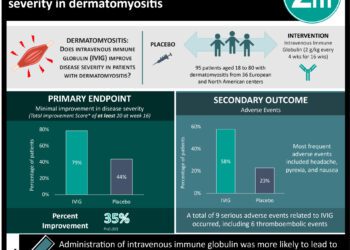Clinical and epidemiological links with calcinosis in adult dermatomyositis
1. In adults with dermatomyositis (DM), calcinosis was positively associated with longer disease duration, fingertip ulcers, and NXP-2 autoantibodies and was negatively associated with anti-TIF-1-g antibodies.
Evidence Rating Level: 2 (Good)
Study Rundown: DM is an autoimmune disease that occasionally involves calcinosis, a sign that results from calcium deposition in the skin and subcutaneous tissues. Several candidate autoantibodies have been associated with DM, though their relationship with calcinosis is poorly understood. In this study, the authors retrospectively analyzed DM from one referral center with the objective of identifying features that associate with calcinosis. After adjusting for confounding variables, authors identified several risk factors including fingertip ulcers, longer duration of disease, and NXP-2 autoantibodies that positively associated with calcinosis. Conversely, the presence of anti-TIF-1- antibodies were found to be protective. Also, the novel finding that calcinosis frequently co-occurs with fingertip ulcers led the authors to hypothesize that a vasculopathy-type process may be common to both pathogeneses. One of the strengths of this study was its large, well-phenotyped cohort that may be difficult to obtain for rare, complex diseases. A key weakness was a potential sampling bias, as only patients from a single tertiary clinic were studied.
Click to read the study in JAMA Dermatology
Relevant reading: Adult and juvenile dermatomyositis: are the distinct clinical features explained by our current understanding of serological subgroups and pathogenic mechanisms?
In-Depth [retrospective cohort]: A total of 126 adult patients from Stanford University Medical Center were screened for a diagnosis of DM from 2006-2013. Of this group, 14 patients (11.1%) were reported to have developed calcinosis. Participants’ medical information was obtained and their plasma was screened for DM-specific and DM-associated autoantibodies using various protein assays. The data were evaluated using univariate and multivariate models and were adjusted for potential confounders. When compared to DM patients without calcinosis, analyses suggested that individuals with calcinosis had longer median disease duration (6.9 years [2.4-18.1] vs. 3.9[0.2-19.2]; p=.003), had more fingertip ulcers (50.0% vs. 9.3%, p<0.001), were more likely to have autoantibodies against NXP-2 (OR, 15.52; 95% CI, 2.0-119.9, p=.009), and were less likely to have anti-TIF-1-g antibodies (OR, 0.2; 95% CI, 0.01-0.99; p=.04). Other antibodies (anti-MDA-5 and anti-Ro-52) were initially identified as positive associations with calcinosis; however, the association wasn’t persistent after separate multivariate models for each antibody were examined.
Image: CC/Wiki
©2012-2014 2minutemedicine.com. All rights reserved. No works may be reproduced without expressed written consent from 2minutemedicine.com. Disclaimer: We present factual information directly from peer reviewed medical journals. No post should be construed as medical advice and is not intended as such by the authors, editors, staff or by 2minutemedicine.com. PLEASE SEE A HEALTHCARE PROVIDER IN YOUR AREA IF YOU SEEK MEDICAL ADVICE OF ANY SORT.





![Weekly dalbavancin noninferior to daily therapy for acute skin infection [DISCOVER 1 and 2 Trials]](https://www.2minutemedicine.com/wp-content/uploads/2014/06/MRSA-aureus-75x75.jpg)